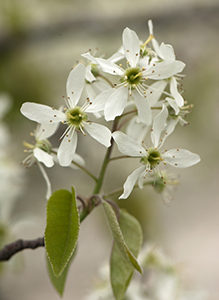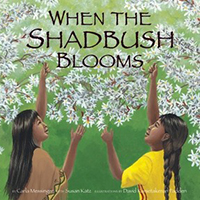Species Spotlight: Secrets of the Shadbush
 When I was an undergraduate student a few years ago (OK, a few decades ago), one of my favorite classes was dendrology. What I really enjoyed was learning hundreds of Latin or Latinized names of the trees of the Northeast and coming to understand what the names mean. For instance, Acer saccharum, with “saccharum” referring to sweet or sugar (think of the artificial sweeter saccharin). No wonder its common name is sugar maple.
When I was an undergraduate student a few years ago (OK, a few decades ago), one of my favorite classes was dendrology. What I really enjoyed was learning hundreds of Latin or Latinized names of the trees of the Northeast and coming to understand what the names mean. For instance, Acer saccharum, with “saccharum” referring to sweet or sugar (think of the artificial sweeter saccharin). No wonder its common name is sugar maple. Common names reveal a lot about a plant if you care to dig a little. Consider the small tree, Amelanchier canadensis (or any of its North American relatives of which there are many,) which often goes by the common name “shadbush.” Now, I learned this common name during my dendrology class. We were told that this plant goes by shadbush because when the shrub is in flower, shad (a type of fish) are spawning in the streams. For me, that was the end of the story.
Fast forward to today. As it turns out, the name “shadbush” does not just signify an interesting coincidence between flowering and spawning. It is much more significant, because for many Native American tribes, its flowering signals the availability of shad as a food source. Today, shadbush flowers earlier in the spring, but its namesake fish species isn’t yet spawning. Thus, this important biological cue is no longer of such cultural value.
 A team of us at Cornell is working with Native American communities to find ways to “recalibrate” this kind of ecological calendar. Specifically, are there other biological cues that can substitute for shadbush, or for any other aspect of Native American cultural tradition? The temporal disconnection between Shadbush blooming and shad spawning is one of numerous examples of how environmental changes are having human cultural consequences, in some cases leading to cultural and language loss. Suffice it to say, we are very good at informing visitors, students, and others about the interesting evolutionary and economic aspects of plants. We hope to do a better job of describing their human cultural values and significance. With a greater awareness of these cultural connections, we will be better stewards of our natural world and of our amazing cultural diversity. Shown right: Amelanchier x grandiflora
A team of us at Cornell is working with Native American communities to find ways to “recalibrate” this kind of ecological calendar. Specifically, are there other biological cues that can substitute for shadbush, or for any other aspect of Native American cultural tradition? The temporal disconnection between Shadbush blooming and shad spawning is one of numerous examples of how environmental changes are having human cultural consequences, in some cases leading to cultural and language loss. Suffice it to say, we are very good at informing visitors, students, and others about the interesting evolutionary and economic aspects of plants. We hope to do a better job of describing their human cultural values and significance. With a greater awareness of these cultural connections, we will be better stewards of our natural world and of our amazing cultural diversity. Shown right: Amelanchier x grandiflora
'Princess Diana' grows in the Newman Arboretum
 For a beautifully told version of the shadbush story, check out the children’s book When the Shadbush Blooms by Carla Messinger and Susan Katz.
For a beautifully told version of the shadbush story, check out the children’s book When the Shadbush Blooms by Carla Messinger and Susan Katz.



